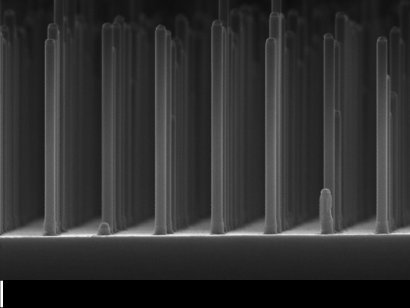Solar cell that produces fuel rather than electricity

Researchers at Eindhoven University of Technology (TU/e) and FOM Foundation have developed a solar cell using gallium phosphide. The material allows the solar cell to produce the clean fuel hydrogen gas from liquid water. Processing the gallium phosphide in the form of very small nanowires is novel and is said to help boost the yield by a factor of 10. And does so using 10,000 times less precious material.
The electricity produced by a solar cell can be used to set off chemical reactions. If this generates a fuel, then one speaks of solar fuels — a hugely promising replacement for polluting fuels. One of the possibilities is to split liquid water using the electricity that is generated (electrolysis). Among oxygen, this produces hydrogen gas that can be used as a clean fuel in the chemical industry or combusted in fuel cells — in cars, for example — to drive engines.
Solar fuel cell
To connect an existing silicon solar cell to a battery that splits the water may well be an efficient solution now but it is a very expensive one. Many researchers are therefore targeting their search at a semiconductor material that is able to both convert sunlight into an electrical charge and split the water, all in one; a kind of ‘solar fuel cell’. Researchers at TU/e and FOM see their dream candidate in gallium phosphide (GaP), a compound of gallium and phosphide that also serves as the basis for specific coloured LEDs.
A tenfold boost
GaP has good electrical properties but the drawback is that it cannot easily absorb light when it is a large flat surface as used in GaP solar cells. The researchers have overcome this problem by making a grid of very small GaP nanowires, measuring 500 nanometres (a millionth of a millimetre) long and 90 nanometres thick. This immediately boosted the yield of hydrogen by a factor of 10 to 2.9%. A record for GaP cells, even though this is still some way off the 15% achieved by silicon cells coupled to a battery.
Less material
According to research leader and TU/e professor Erik Bakkers, it’s not simply about the yield — where there is still a lot of scope for improvement he points out: “For the nanowires we needed 10,000 less precious GaP material than in cells with a flat surface. That makes these kinds of cells potentially a great deal cheaper,” Bakkers said. “In addition, GaP is also able to extract oxygen from the water — so you then actually have a fuel cell in which you can temporarily store your solar energy. In short, for a solar fuels future we cannot ignore gallium phosphide any longer.”
This research was performed within the BioSolar Cells program jointly funded by FOM Foundation, NWO (Netherlands Organization for Scientific Research) and the Ministry of Economic Affairs.
Predictive AI model enhances solid-state battery design
ECU researchers are working on ways to make solid-state batteries more reliable with the help of...
Boosting performance of aqueous zinc–iodine batteries
Engineers from the University of Adelaide have enhanced aqueous zinc–iodine batteries using...
Sodium-ion battery breakthrough boosts energy storage
Scientists have discovered that leaving water inside a key material, rather than removing it,...




